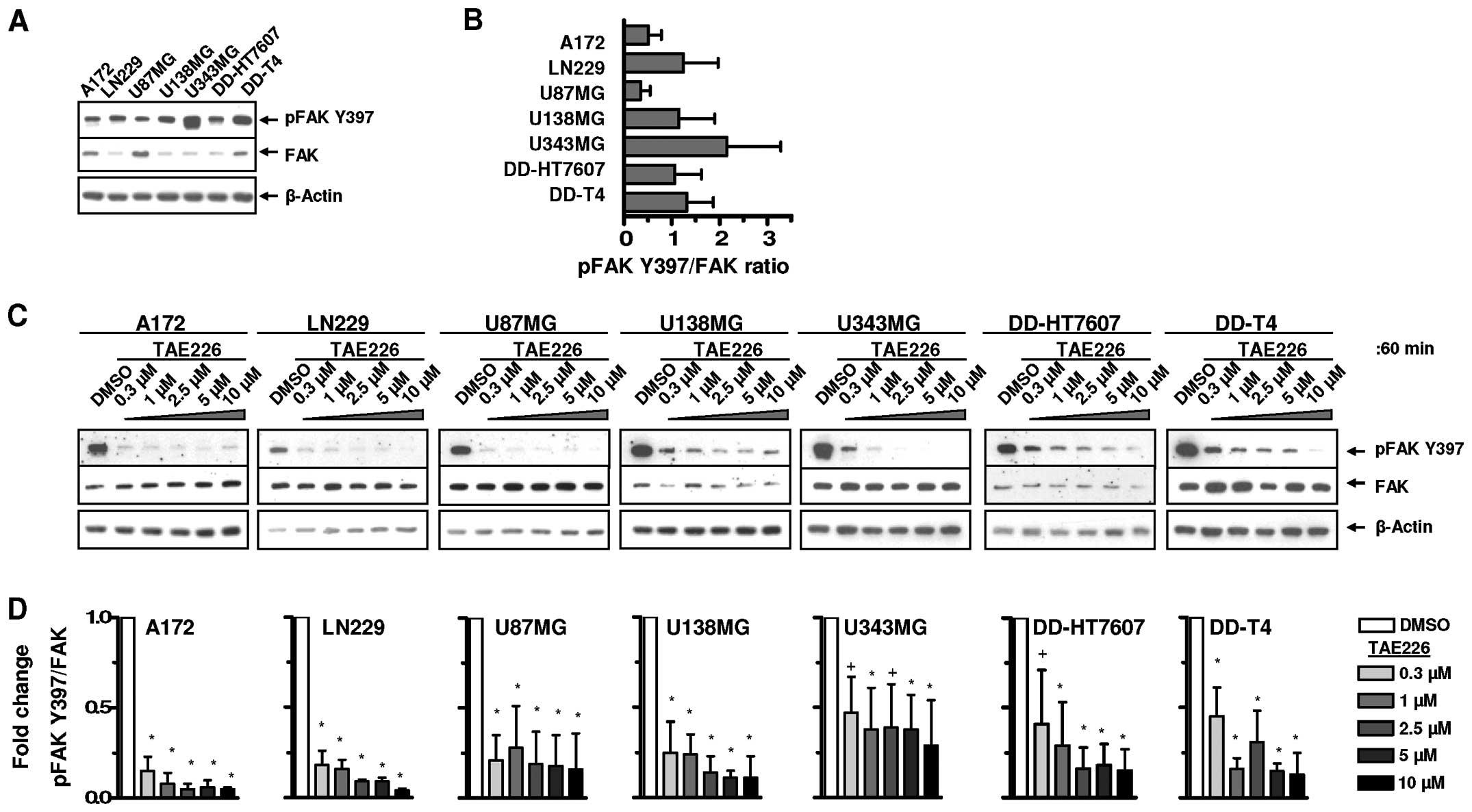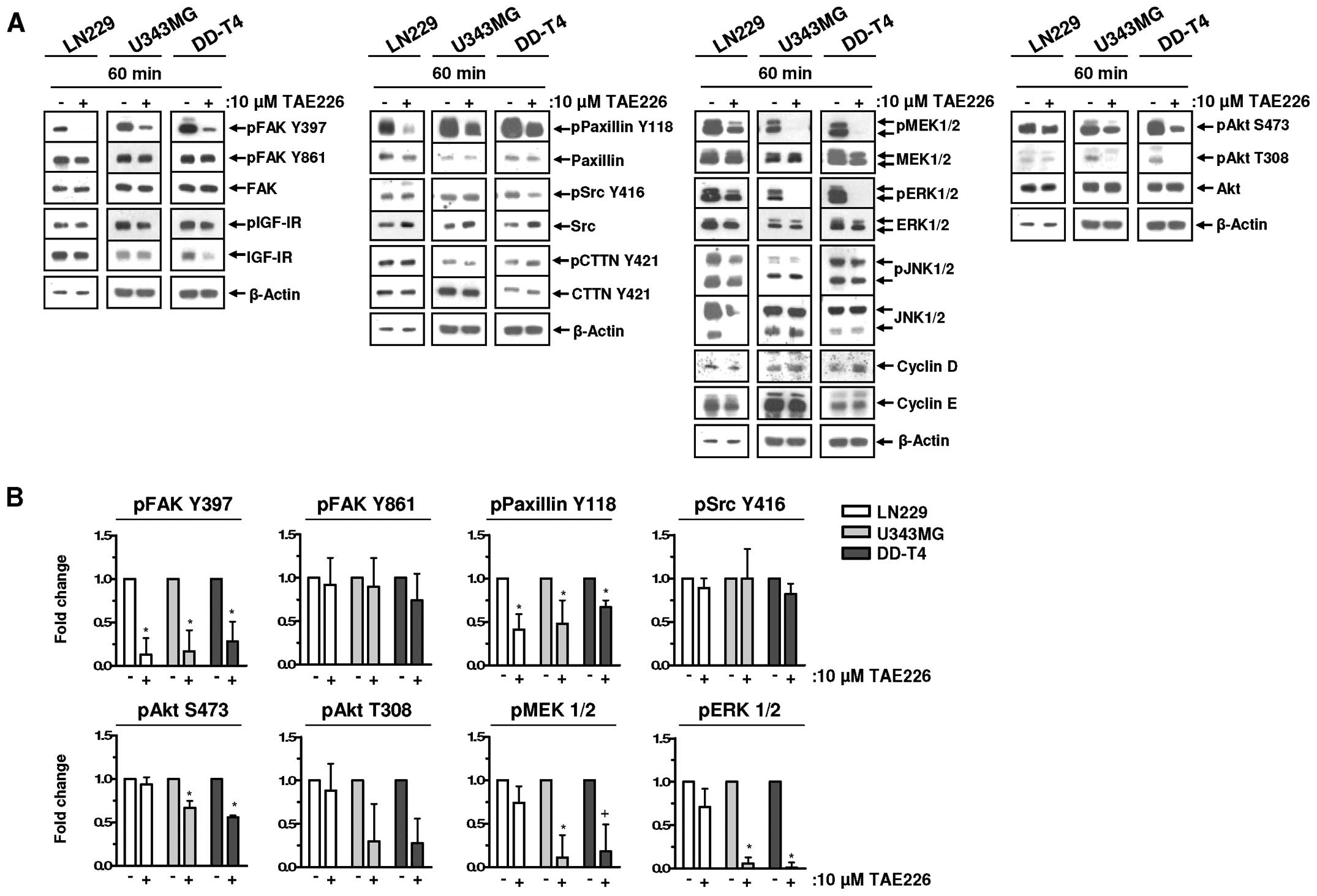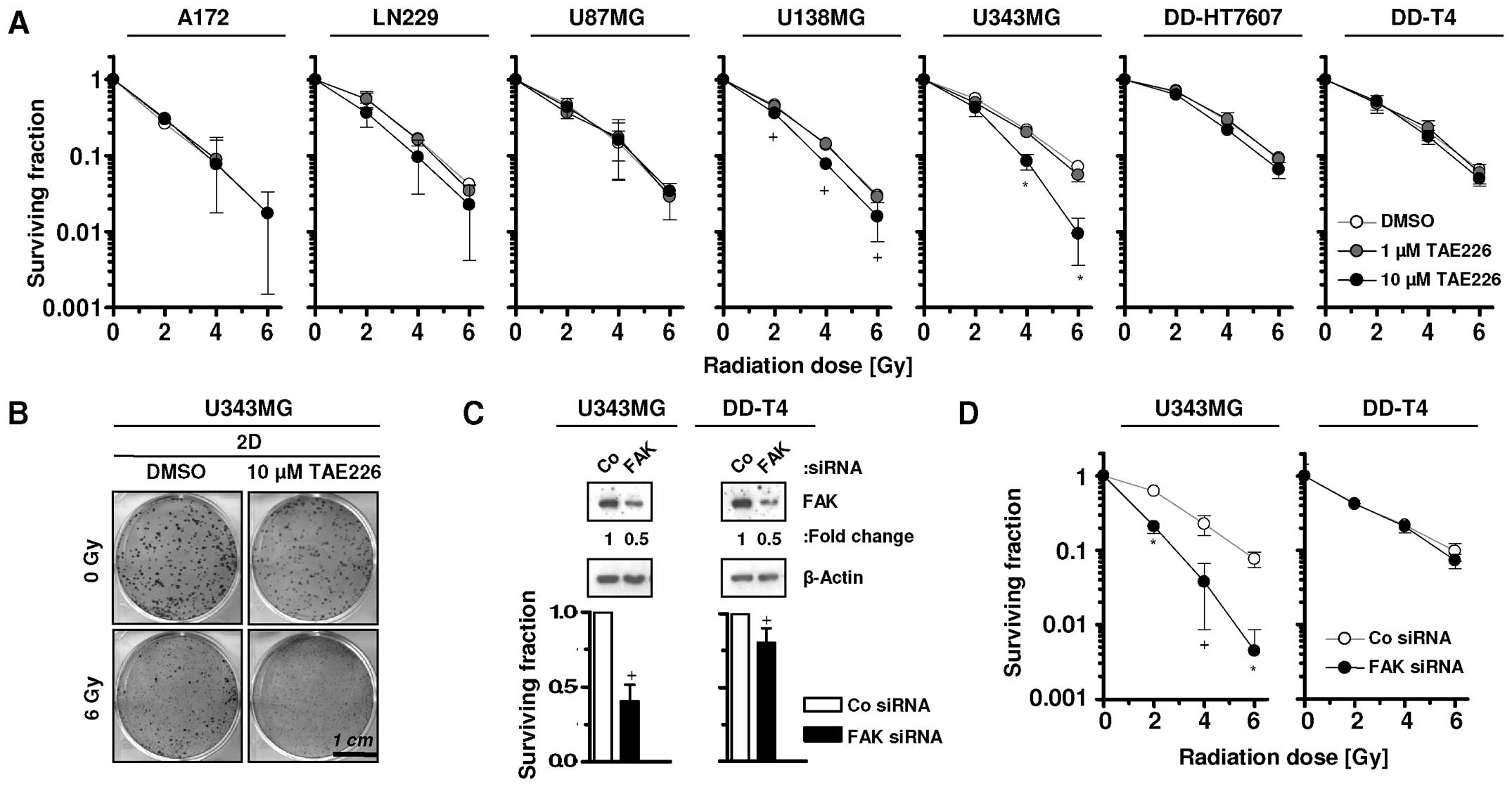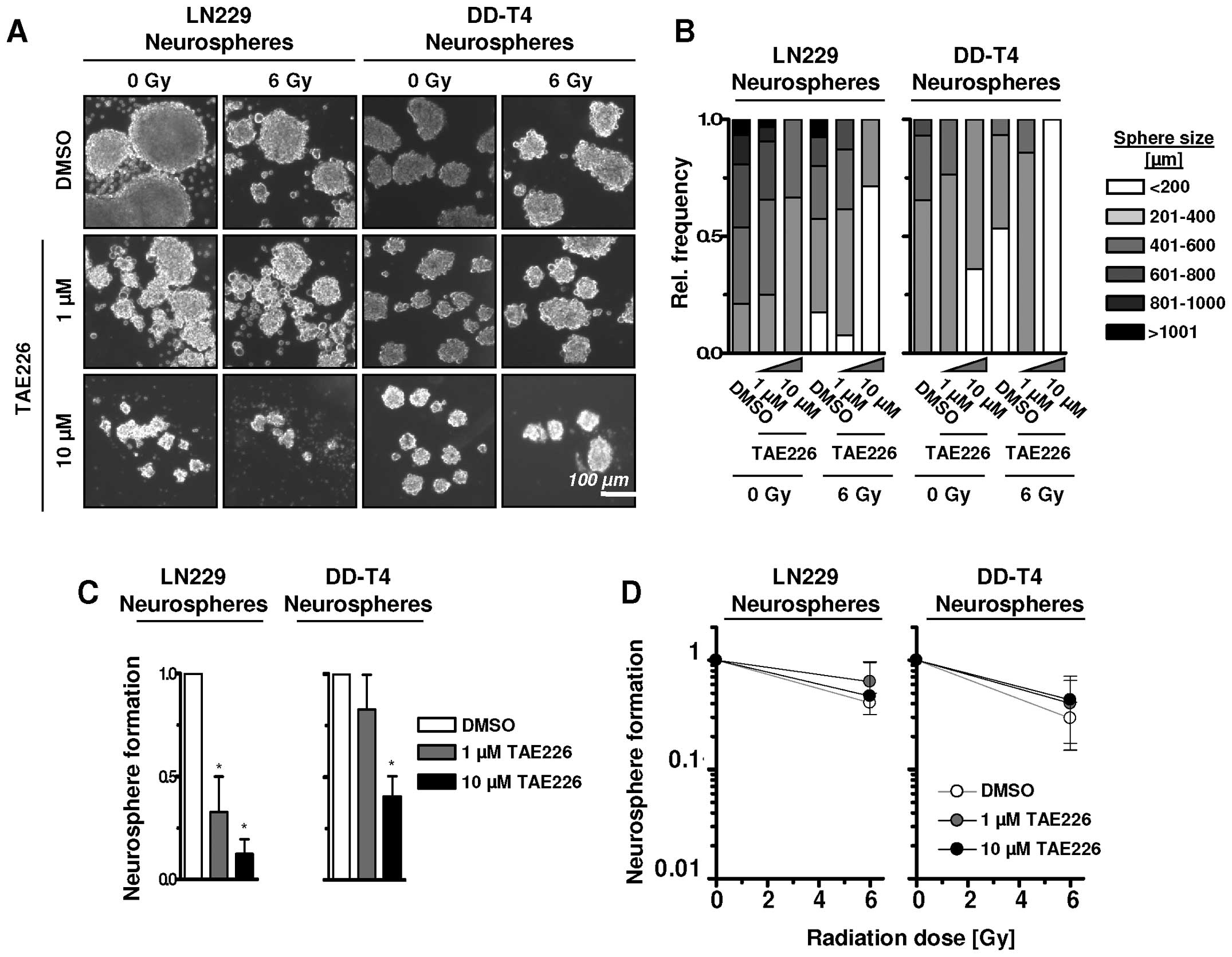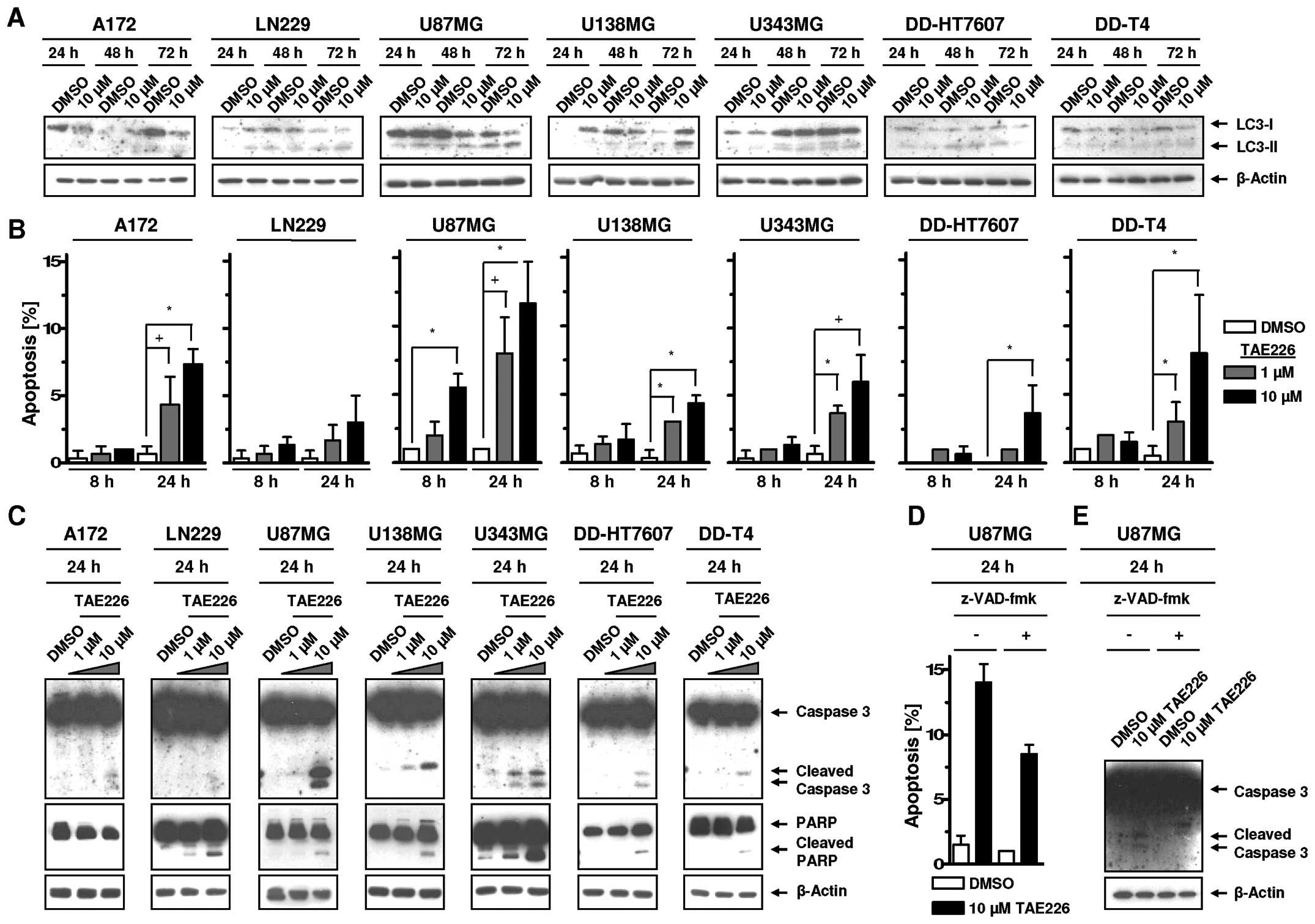Cytotoxic and radiosensitizing effects of FAK targeting in human glioblastoma cells in vitro
- Authors:
- Published online on: January 27, 2015 https://doi.org/10.3892/or.2015.3753
- Pages: 2009-2016
Abstract
Introduction
Glioblastoma multiforme (GBM) is the most frequent malignant primary brain tumor in adults and is characterized by an aggressive infiltrative growth (1,2). To improve the efficacy of current multimodal therapeutic approaches composed of neurosurgery, radiotherapy and chemotherapy (3), identification of key molecular determinants of radio- and chemoresistance is required. Among the plethora of potential target molecules in GBM, integrins and integrin-associated signaling molecules, such as focal adhesion kinase (FAK), demonstrated promising results in preclinical and early clinical studies (4–8). Peptidomimetic cilengitide, which blocks the RGD binding site of αv/β3 and αv/β5 integrins (9,10), is the only target strategy that has been previously clinically evaluated. Due to a variety of prosurvival bypass signaling opportunities via other integrin receptors, cilengitide failed to improve overall survival of patients with GBM in Phase IV clinical trials (http://www.merck.com). Despite this drawback, targeting of integrin downstream signaling mediators such as FAK seems reasonable and likely to yield promising results.
FAK is a non-receptor protein-tyrosine kinase that provides signaling and scaffolding functions downstream of integrins. EGFR plays an important role in the regulation of cell processes such as adhesion, survival, migration and invasion (11,12). As FAK is overexpressed in a variety of human tumors including brain, head and neck squamous cell carcinoma (HNSCC), breast, prostate, colon, ovarian, lung, and liver (13–19), targeting of FAK is a promising approach to overcome cancer therapy resistance. Several FAK inhibitors are currently under investigation in clinical trials (http://www.clinicaltrials.gov/ct2/results?term=FAK).
Previously, radiosensitization of human pancreatic and HNSCC was shown by siRNA-mediated FAK knockdown or pharmacological FAK inhibition using TAE226 (20–23). In glioblastoma cells, antisense oligonucleotides against FAK enhanced the sensitivity of U251MG cells to chemotherapy such as cisplatin (24). Moreover, TAE226 exhibited a variety of effects in human GBM cells such as delay in proliferation, G2-phase cell cycle arrest, increased apoptosis and attenuated adhesion, migration and invasion (5,7). Of note, studies in intracranial glioblastoma xenograft models showed prolonged survival following TAE226 treatment (5). Due to the fact that patients suffering from GBM received radiotherapy, we assessed the radiosensitizing potential of FAK inhibition using TAE226 in a panel of human glioblastoma cell lines.
Materials and methods
Antibodies and reagents
Antibodies against FAK Y861 (Abcam, Cambridge, UK), Akt, phospho-Akt S473, phospho-Akt T308, caspase-3, CTTN, phospho-CTTN Y421, cyclin E, ERK1/2, phospho-ERK1/2, FAK, phospho-FAK Y397, IGF-IR, phospho-IGF-IR, JNK, phospho-JNK1/2, LC3-I/II, MEK1/2, phospho-MEK1/2, PARP, Paxillin, phospho-Paxillin Y118, Src, phospho-Src Y118 (Cell Signaling, Danvers, MA, USA), phospho-JNK1/2 (Invitrogen-Life Technologies, Carlsbad, CA, USA), β-actin (Sigma, St. Louis, MO, USA), cyclin D (Zymed), horseradish peroxidase-conjugated donkey anti-rabbit and sheep anti-mouse (Amersham, Poole, UK) were purchased as indicated. Caspase-3 inhibitor Z-VAD (OMe)-FMK was purchased from Calbiochem (San Diego, CA, USA). The FAK inhibitor TAE226 was kindly provided by Novartis (Cambridge, MA, USA). Enhanced chemiluminescent reagent (ECL) was purchased from Amersham, dimethyl sulfoxide (DMSO) from Applichem (Darmstadt, Germany) and Vectashield/DAPI mounting medium from Alexis (Grünberg, Germany).
Cell culture and X-ray radiation exposure
Human A172, LN229, U87MG, U138MG and U343MG glioblastoma cell lines were obtained from ATCC, while DD-HT7607 and DD-T4 were provided by A. Temme (University Hospital Dresden). The cells were cultured in Dulbecco’s modified Eagle’s medium (PAA; plus glutamax-I) supplemented with 10% fetal calf serum (PAA) and 1% non-essential amino acids (PAA). The U343MG cell line was cultured in Basal Medium Eagle (Life Technologies), supplemented with 10% fetal calf serum (PAA), 10 mM Hepes, 2 mM L-glutamine, 1% penicillin/streptomycin (pen/strep) and 1% non-essential amino acids (PAA) at 37°C in a humidified atmosphere containing 7% CO2. Single doses of 200 kV X-rays (2, 4 or 6 Gy; Yxlon Y.TU 320; Yxlon; 0.5 mm copper filter; ~1.3 Gy/min, 20 mA) were applied at room temperature and measured using a Duplex dosimeter (PTW).
Colony formation assay
Measurement of 2D cell survival was performed as previously published (25). Briefly, single cells were plated in 6-well cell culture dishes (BD Biosciences, Heidelberg, Germany). After 24 h, the cells were treated with indicated amounts of TAE226 or DMSO. In the case of irradiation experiments, TAE226 or DMSO was applied 1, 8 or 24 h prior to irradiation and removed 3 h after irradiation (single X-ray doses: 2, 4, and 6 Gy). After 9–12 days, depending on the cell line, 2D cell colonies were stained with Coomassie blue (Merck, Darmstadt, Germany) and counted microscopically. Colonies were defined by cell numbers >50. Plating efficiencies were calculated as: Number of colonies formed/number of cells plated. Surviving fractions were calculated as: number of colonies formed/(number of cells plated (irradiated) × plating efficiency (unirradiated). Each point on the survival curves was the mean surviving fraction from at least three independent experiments.
Neurosphere assay
Anchorage-independent growth was enabled using neurobasal medium (PAA), containing 32 U/ml heparine, 20 μl/ml B27 supplement, 10 μl/ml glutamax, 20 ng/ml FGF, 20 ng/ml EGF, 1% pen/strep and 1% fungizone (26). The cells were trypsinized and resuspended in neurobasal medium and conferred to plates coated with Ultra-Low attachment surface (Corning, Lowell, MA, USA). After 24 h, the cells were treated with the indicated amounts of TAE226 or DMSO. For the irradiation experiments, TAE226 or DMSO was applied 24 h prior to irradiation (single X-ray doses: 2, 4, and 6 Gy). After 9–12 days, depending on the cell line, the number of spheres with a diameter of ≥200 μm were counted microscopically. Representative images were captured using an Axioscope 2 microscope (Carl Zeiss, Thornwood, NY, USA) to calculate the sphere size.
DAPI staining
For the apoptosis analysis, the cells were treated at the indicated time points (8 or 24 h) and fixed with 80% ethanol for at least 24 h as previously published (25). Typical apoptotic nuclear shape was analyzed using Vectashield/DAPI mounting medium. Apoptotic nuclei of ≥100 cells from three independent experiments were counted microscopically using an Axioscope 2 microscope (Zeiss).
Total protein extracts and western blotting
Total protein extracts from 2D cell cultures were isolated as previously described (25). Therefore, the cells were lysed using modified RIPA buffer [50 mM Tris-HCl (Carl Roth, Karlsruhe, Germany, (pH, 7.4)], 1% Nonidet-P40 (Sigma-Aldrich, Taufkirchen, Germany), 0.25% sodium deoxycholate (Applichem), 150 mM NaCl (VWR International, Darmstadt, Germany), 1 mM ethylenediaminetetraacetic acid (Merck), complete protease inhibitor cocktail (Roche, Mannheim, Germany), 1 mM NaVO4 (Applichem), 2 mM NaF (Applichem). The samples were stored at −80°C. The total protein amount was measured using the bicinchoninic acid assay (Pierce, Bonn, Germany). The 2D monolayer cells were treated with FAK inhibitor (TAE226, 0.3–10 μM) for 1, 8 or 24 h and subsequently with Caspase 3 inhibitor [Z-VAD (OMe)-FMK, 100 μM] for 1 h pretreatment, where appropriate.
siRNA-mediated knockown of FAK
FAK siRNA (sense 5′-CCAAAUUCGAGUACUAAGAtt-3′) was obtained from Ambion (Austin, TX, USA). A non-specific siRNA (sense 5′-GCAGCUAUAUGAAUGUUGUtt-3′; MWG) was used as the control. The cells were prepared for siRNA transfection (20 nmol/l) with oligofectamine and were subjected 24 h after transfection to a colony formation assay and western blotting.
Statistical analysis
Data are presented as the mean ± SD values. The level of significance was determined by the Student’s t-test (Microsoft Excel 2010). P<0.05 was considered statistically significant.
Results
TAE226 effectively reduces FAK phosphorylation in human glioblastoma cells
Basal FAK expression and Y397 phosphorylation were examined using a panel of human glioblastoma cell lines (Fig. 1A and B). The inhibitory potential of TAE226 on FAK Y397 autophosphorylation was subsequently assessed (Fig. 1C). TAE226-mediated FAK Y397 dephosphorylation was, although cell line-dependent, not clearly concentration-dependent over the range of 0.3–10 μM (Fig. 1C and D).
TAE226 efficiently reduces FAK autophosphorylation and modulates downstream signaling molecules
We systematically analyzed the potential of TAE226 on various signaling pathways in the LN229, U343MG and DD-T4 glioblastoma cells. FAK and insulin-like growth factor-I receptor (IGF-IR), both reported as targets of TAE226 (27), showed a different response to TAE226 treatment. FAK was dephosphorylated, whereas no modification was detected for IGF-IR (Fig. 2A and B). In the three glioma cells, Paxillin Y118 phosphorylation was reduced by TAE226, while only U343MG and DD-T4 cells revealed reduced phosphorylation of Akt S473/T308, MEK1/2 and ERK1/2 following TAE226 relative to DMSO (Fig. 2A and B). TAE226 treatment did not affect Src, CTTN and JNK1/2 or the expression of cell cycle proteins Cyclin D or E (Fig. 2A and B).
TAE226 differentially radiosensitizes glioblastoma cells
Cytotoxic effects of TAE226 have been previously reported (4–8). In the present study, we examined the radiosensitizing potential of TAE226 in glioblastoma cells. TAE226 failed to radiosensitize the tested glioma cells when pretreated with 1 μM TAE226, whereas 10 μM TAE226 pretreatment significantly radiosensitized U138MG and U343MG cells (Fig. 3A and B). Additionally, whether siRNA-mediated FAK targeting provides similar effects, was assessed in U343MG and DD-T4 glioma cells (Fig. 3C). The results showed that U343MG, but not DD-T4, cells were significantly radiosensitized by this approach (Fig. 3D).
TAE226 reduces sphere growth without changing glioblastoma radiosensitivity
TAE226 efficacy in glioblastoma suspension cell cultures in neural basal media was examined. Under these conditions, treatment of single GBM cells with TAE226 led to a shift from larger to smaller spheres with diameters ranging from >1001 to <200 μm (Fig. 4A and B). Combined with a 6-Gy single X-ray dose, the frequency of smaller spheres further increased in LN229 and DD-T4 cells (Fig. 4A and B). In line with sphere size, sphere number of LN229 and DD-T4 cells was significantly reduced by 1 or 10 μM TAE226 alone (Fig. 4C) while radiosensitization in the GBM cells grown as spheres was lacking (Fig. 4D). Thus, under 3D suspension growth conditions, TAE226 has a strong potential for growth inhibition but not for radiosensitization of GBM cells.
TAE226-mediated FAK inhibition induces apoptosis but not autophagic cell death in glioblastoma cells
To assess whether TAE226 induces autophagy and apoptosis in glioblastoma cell lines, we measured LC3-I and LC3-II expression, apoptotic cell nuclei, Caspase 3 and PARP cleavage. In our analysis, LC3-I to LC3-II conversion was not clearly observable following TAE226 indicating autophagy was not an essential cell death process in the examined glioma cells (Fig. 5A). However, TAE226 increased apoptosis relative to DMSO controls in a cell line-, dose- and time-dependent manner (Fig. 5B). The magnitude of apoptosis was not reflected by the degree of cleaved Caspase 3 and PARP (Fig. 5C). By means of the Caspase inhibitor Z-VAD (OMe)-fmk, we showed in U87MG cells with the highest rate of TAE226-induced apoptosis that Caspase 3 cleavage can be completely prevented while the number of apoptotic nuclei is only reduced by ~40% (Fig. 5D and E). These data suggested apoptosis induction, but not autophagy, contributed to the cytotoxicity of TAE226.
TAE226 strongly attenuates clonogenic cell survival of glioblastoma cells
The impact of TAE226 to reduce clonogenicity of glioblastoma cells was investigated. Increasing TAE226 concentrations significantly reduced the clonogenic survival of all tested glioblastoma cells in a time-dependent manner in comparison to DMSO control.
Discussion
Optimization of multimodal therapy concepts for GBM is necessary. In this study, we investigated the radiosensitizing and cytotoxic potential of the pharmacological FAK inhibitor TAE226 in glioblastoma cells. We found significant dose- and time-dependent cytotoxicity of TAE226 in a panel of seven human glioblastoma cell lines.
These results are in concordance with previous studies in which TAE226 caused growth inhibition and apoptosis induction in different tumor entities such as glioblastoma (7), neuroblastoma (28), head and neck squamous cell carcinoma (HNSCC) (21,23), esophageal tumors (29) and breast cancer (30). However, monotherapy using a FAK inhibitor is unlikely to occur in the clinic and, thus, knowledge concerning the radiosensitizing potential of TAE226 is of great relevance. TAE226 is described as a potent inhibitor of the tyrosin protein kinases FAK and IGF-IR. Contrary to previously published data (5,23,27), we found significantly reduced FAK Y397 autophosphorylation without modification of IGF-IR phosphorylation following TAE226 application in glioblastoma cells. Similar to other studies (5,23), FAK inhibition led to alterations of adapter and signaling molecules directly or partly associated with FAK such as Paxillin, Akt, MEK1/2 and ERK1/2.
Owing to this multitarget deactivation, TAE226 mediated strong cytotoxicity that may be attributed to apoptosis but not autophagy. Similar data have been published by other authors (7,24). Moreover, this apoptosis induction presented partly Caspase-dependent and partly Caspase-independent, thus further mechanistic examination is required. Of note, apoptosis or anoikis is stimulated following TAE226-dependent FAK Y397 autophosphorylation in GBM cells indicating the importance of integrin-mediated anchorage-dependent growth of GBM cells. The broad inhibitory spectrum of TAE226 is beneficial to induced cell death in suspension cell cultures, in which cell-ECM interactions are less relevant for cell survival. Hypothesizing TAE226 to activate different cell death modes under adhesion vs. suspension seems of high interest for the clinical scenario where different GBM cell populations compose the tumor heterogeneity and are likely to be differentially dependent on adhesion.
Based on the fact that small molecules are administered in combination with conventional radiotherapy or radiochemotherapy, we investigated TAE226 plus irradiation and found that only a small number of GBM cell lines are radiosensitized. Previous studies testing TAE226/irradiation showed that head and neck cancer cells, but not carcinoma cells, from lung, colorectum and pancreas can be sensitized to radiotherapy (21,23). Targeting of β1 integrin, located upstream of FAK, mediated less cytotoxicity than TAE226 but radiosensitization in human GBM cell lines (4). These observations suggest that: i) GBM cell survival is highly FAK-dependent; ii) the molecular circuitry controlled by targets of TAE226 does not essentially contribute to the DNA damage response of GBM cells.
In conclusion, our findings demonstrate that the pharmacological FAK inhibitor TAE226 efficiently reduces clonogenic survival without radiosensitization in a panel of glioblastoma cell lines. In the future, the identification of the integrin-related adhesome seems to be key for the optimization of therapeutic strategies for GBM as the multiprotein-multifunctional adhesome complexes control prosurvival signaling and invasion processes.
Acknowledgements
This study was supported by The German Federal Ministry of Education and Research; contract grant number: BMBF Contract 03ZIK041 (to N.C.) and by The Saxon Ministry of Science and Arts and the EFRE Europäische Fonds für regionale Entwicklung, Europa fördert Sachsen; Contract grant no. 100066308. We are grateful to A. Temme (University Hospital Dresden, Germany) for providing U343MG, DD-HT7607 and DD-T4 cells. The pharmacological FAK inhibitor TAE226 was kindly provided by Novartis Institutes of Biomedical Research, Inc. (Cambridge, MA, USA).
References
|
Louis DN, Ohgaki H, Wiestler OD, Cavenee WK, Burger PC, Jouvet A, Scheithauer BW and Kleihues P: The 2007 WHO classification of tumours of the central nervous system. Acta Neuropathol. 114:97–109. 2007. View Article : Google Scholar : PubMed/NCBI | |
|
Bleeker FE, Molenaar RJ and Leenstra S: Recent advances in the molecular understanding of glioblastoma. J Neurooncol. 108:11–27. 2012. View Article : Google Scholar : PubMed/NCBI | |
|
Becker KP and Yu J: Status quo - standard-of-care medical and radiation therapy for glioblastoma. Cancer J. 18:12–19. 2012. View Article : Google Scholar : PubMed/NCBI | |
|
Eke I, Storch K, Kastner I, Vehlow A, Faethe C, Mueller-Klieser W, Taucher-Scholz G, Temme A, Schackert G and Cordes N: Three-dimensional invasion of human glioblastoma cells remains unchanged by X-ray and carbon ion irradiation in vitro. Int J Radiat Oncol Biol Phys. 84:e515–e523. 2012. View Article : Google Scholar : PubMed/NCBI | |
|
Liu TJ, LaFortune T, Honda T, Ohmori O, Hatakeyama S, Meyer T, Jackson D, de Groot J and Yung WK: Inhibition of both focal adhesion kinase and insulin-like growth factor-I receptor kinase suppresses glioma proliferation in vitro and in vivo. Mol Cancer Ther. 6:1357–1367. 2007. View Article : Google Scholar : PubMed/NCBI | |
|
Rieken S, Habermehl D, Mohr A, Wuerth L, Lindel K, Weber K, Debus J and Combs SE: Targeting ανβ3 and ανβ5 inhibits photon-induced hypermigration of malignant glioma cells. Radiat Oncol. 6:1322011. View Article : Google Scholar | |
|
Shi Q, Hjelmeland AB, Keir ST, Song L, Wickman S, Jackson D, Ohmori O, Bigner DD, Friedman HS and Rich JN: A novel low-molecular weight inhibitor of focal adhesion kinase, TAE226, inhibits glioma growth. Mol Carcinog. 46:488–496. 2007. View Article : Google Scholar : PubMed/NCBI | |
|
Yang M, Li Y, Chilukuri K, Brady OA, Boulos MI, Kappes JC and Galileo DS: L1 stimulation of human glioma cell motility correlates with FAK activation. J Neurooncol. 105:27–44. 2011. View Article : Google Scholar : PubMed/NCBI | |
|
Reardon DA, Nabors LB, Stupp R and Mikkelsen T: Cilengitide: an integrin-targeting arginine-glycine-aspartic acid peptide with promising activity for glioblastoma multiforme. Expert Opin Investig Drugs. 17:1225–1235. 2008. View Article : Google Scholar : PubMed/NCBI | |
|
Nabors LB, Mikkelsen T, Hegi ME, Ye X, Batchelor T, Lesser G, Peereboom D, Rosenfeld MR, Olsen J, Brem S, Fisher JD and Grossman SA: A safety run-in and randomized phase 2 study of cilengitide combined with chemoradiation for newly diagnosed glioblastoma (NABTT 0306). Cancer. 118:5601–5607. 2012. View Article : Google Scholar : PubMed/NCBI | |
|
McLean GW, Carragher NO, Avizienyte E, Evans J, Brunton VG and Frame MC: The role of focal-adhesion kinase in cancer - a new therapeutic opportunity. Nat Rev Cancer. 5:505–515. 2005. View Article : Google Scholar : PubMed/NCBI | |
|
Zhao J and Guan JL: Signal transduction by focal adhesion kinase in cancer. Cancer Metastasis Rev. 28:35–49. 2009. View Article : Google Scholar : PubMed/NCBI | |
|
Cance WG, Harris JE, Iacocca MV, Roche E, Yang X, Chang J, Simkins S and Xu L: Immunohistochemical analyses of focal adhesion kinase expression in benign and malignant human breast and colon tissues: correlation with preinvasive and invasive phenotypes. Clin Cancer Res. 6:2417–2423. 2000.PubMed/NCBI | |
|
Glukhova M, Koteliansky V, Sastre X and Thiery JP: Adhesion systems in normal breast and in invasive breast carcinoma. Am J Pathol. 146:706–716. 1995.PubMed/NCBI | |
|
Gutenberg A, Brück W, Buchfelder M and Ludwig HC: Expression of tyrosine kinases FAK and Pyk2 in 331 human astrocytomas. Acta Neuropathol. 108:224–230. 2004.PubMed/NCBI | |
|
Han NM, Fleming RY, Curley SA and Gallick GE: Overexpression of focal adhesion kinase (p125FAK) in human colorectal carcinoma liver metastases: independence from c-src or c-yes activation. Ann Surg Oncol. 4:264–268. 1997. View Article : Google Scholar : PubMed/NCBI | |
|
Hsu NY, Chen CY, Hsu CP, Lin TY, Chou MC, Chiou SH and Chow KC: Prognostic significance of expression of nm23-H1 and focal adhesion kinase in non-small cell lung cancer. Oncol Rep. 18:81–85. 2007.PubMed/NCBI | |
|
Kornberg LJ: Focal adhesion kinase expression in oral cancers. Head Neck. 20:634–639. 1998. View Article : Google Scholar : PubMed/NCBI | |
|
Owens LV, Xu L, Craven RJ, Dent GA, Weiner TM, Kornberg L, Liu ET and Cance WG: Overexpression of the focal adhesion kinase (p125FAK) in invasive human tumors. Cancer Res. 55:2752–2755. 1995.PubMed/NCBI | |
|
Cordes N, Frick S, Brunner TB, Pilarsky C, Grützmann R, Sipos B, Kloppel G, McKenna WG and Bernhard EJ: Human pancreatic tumor cells are sensitized to ionizing radiation by knockdown of caveolin-1. Oncogene. 26:6851–6862. 2007. View Article : Google Scholar : PubMed/NCBI | |
|
Eke I and Cordes N: Dual targeting of EGFR and focal adhesion kinase in 3D grown HNSCC cell cultures. Radiother Oncol. 99:279–286. 2011. View Article : Google Scholar : PubMed/NCBI | |
|
Hehlgans S, Eke I and Cordes N: Targeting FAK radiosensitizes 3-dimensional grown human HNSCC cells through reduced Akt1 and MEK1/2 signaling. Int J Radiat Oncol Biol Phys. 83:e669–e676. 2012. View Article : Google Scholar : PubMed/NCBI | |
|
Hehlgans S, Lange I, Eke I and Cordes N: 3D cell cultures of human head and neck squamous cell carcinoma cells are radiosensitized by the focal adhesion kinase inhibitor TAE226. Radiother Oncol. 92:371–378. 2009. View Article : Google Scholar : PubMed/NCBI | |
|
Wu ZM, Yuan XH, Jiang PC, Li ZQ and Wu T: Antisense oligonucleodes targeting the focal adhesion kinase inhibit proliferation, induce apoptosis and cooperate with cytotoxic drugs in human glioma cells. J Neurooncol. 77:117–123. 2006. View Article : Google Scholar | |
|
Storch K, Eke I, Borgmann K, Krause M, Richter C, Becker K, Schröck E and Cordes N: Three-dimensional cell growth confers radioresistance by chromatin density modification. Cancer Res. 70:3925–3934. 2010. View Article : Google Scholar : PubMed/NCBI | |
|
Günther HS, Schmidt NO, Phillips HS, Kemming D, Kharbanda S, Soriano R, Modrusan Z, Meissner H, Westphal M and Lamszus K: Glioblastoma-derived stem cell-enriched cultures form distinct subgroups according to molecular and phenotypic criteria. Oncogene. 27:2897–2909. 2008. View Article : Google Scholar | |
|
Wang ZG, Fukazawa T, Nishikawa T, Watanabe N, Sakurama K, Motoki T, Takaoka M, Hatakeyama S, Omori O, Ohara T, Tanabe S, Fujiwara Y, Shirakawa Y, Yamatsuji T, Tanaka N and Naomoto Y: TAE226, a dual inhibitor for FAK and IGF-IR, has inhibitory effects on mTOR signaling in esophageal cancer cells. Oncol Rep. 20:1473–1477. 2008.PubMed/NCBI | |
|
Beierle EA, Trujillo A, Nagaram A, Golubovskaya VM, Cance WG and Kurenova EV: TAE226 inhibits human neuroblastoma cell survival. Cancer Invest. 26:145–151. 2008. View Article : Google Scholar : PubMed/NCBI | |
|
Watanabe N, Takaoka M, Sakurama K, Tomono Y, Hatakeyama S, Ohmori O, Motoki T, Shirakawa Y, Yamatsuji T, Haisa M, Matsuoka J, Beer DG, Nagatsuka H, Tanaka N and Naomoto Y: Dual tyrosine kinase inhibitor for focal adhesion kinase and insulin-like growth factor-I receptor exhibits anticancer effect in esophageal adenocarcinoma in vitro and in vivo. Clin Cancer Res. 14:4631–4639. 2008. View Article : Google Scholar : PubMed/NCBI | |
|
Golubovskaya VM, Virnig C and Cance WG: TAE226-induced apoptosis in breast cancer cells with overexpressed Src or EGFR. Mol Carcinog. 47:222–234. 2008. View Article : Google Scholar |



